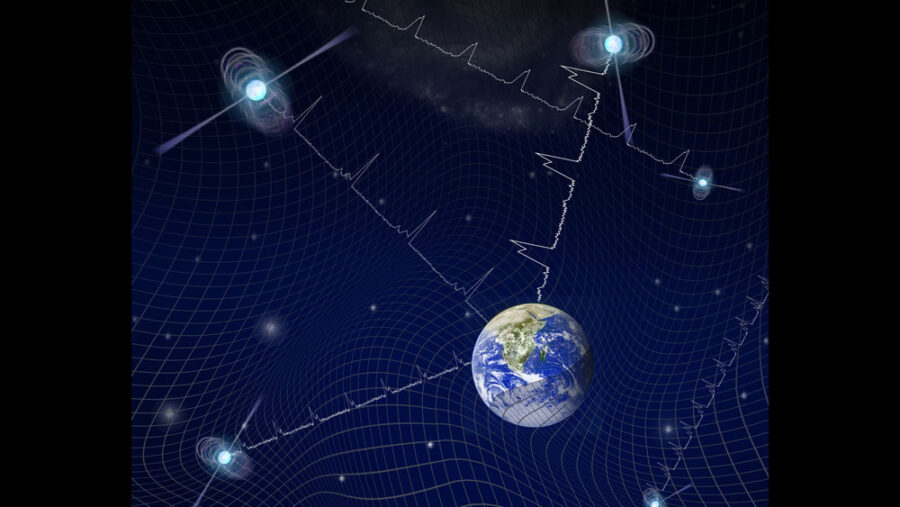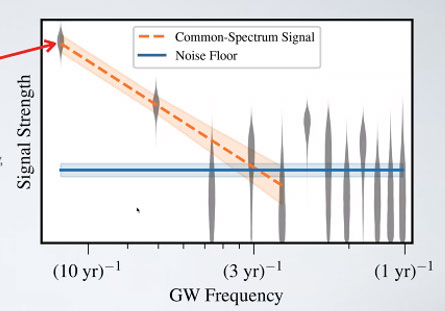Duos of supermassive black holes tangoing throughout the universe make their own music, and astronomers may have picked up a hint of the tune.

NANOGrav / T. Klein
When two stellar-mass black holes collide, they make a distinctive “pop!” of gravitational waves that surges over Earth (and over the LIGO and Virgo detectors). But when two supermassive black holes merge, their pop draws out like the sound in a slow-motion video, a years-long signal that blends in with those of all the other supermassive black hole binaries in the universe. A constant low-frequency symphony of gravitational waves washes over our planet.
Pulsar-monitoring projects such as the North American Nanohertz Observatory for Gravitational Waves (NANOGrav) have been on the lookout for this background buzz for more than a decade — and at the 237th meeting of the American Astronomical Society (AAS), the NANOGrav collaboration announced that it has detected a hint of the tune.
A Galaxy-Wide Detector
Pulsars, the compressed remainders of massive supernova explosions, appear to pulse in the sky as they spin, their jets of plasma sweeping past Earth like lighthouse beams.
For astronomers, though, a better analogy would be the pendulums of cosmic clocks. Millisecond pulsars, which whirl around as fast as the blades in a kitchen blender, keep especially regular time, rivaling atomic clocks on Earth.
Clocks respond to gravity just as much as mass does, and as early as 1979 astronomers were already dreaming of using these timekeepers to search for gravitational waves. Astronomers have since set up pulsar timing arrays to monitor millisecond pulsars across the galaxy, looking for minute changes in their signals. NANOGrav started with 17 pulsars and now has 45 with more than three years’ worth of observations from the Green Bank and Arecibo radio telescopes.
“We created a galaxy-size detector within our own Milky Way,” says Joe Simon (JPL-Caltech and University of Colorado, Boulder), lead scientist on the search for a gravitational-wave background presented in Astrophysical Journal Letters.
And after 12½ years of operating that galaxy-wide detector, Simon reported at the AAS that NANOGrav has detected a low-frequency signal that looks exactly like what they would expect from the gravitational-wave background.

Arzoumanian et al. / Astrophysical Journal Letters 2020 / modifications by J. Simon (lead author)
“We walked through each of the pulsars one by one. I think we were all expecting to find a few that were the screwy ones throwing off our data,” Simon says. “But then we got through them all, and we said, ‘Oh my God, there’s actually something here.’”
Nevertheless, while the team is certain there is a signal there, they’re still not sure what it is.
Is It Gravitational Waves?
To establish that the low-frequency buzz comes from gravitational waves, most likely emitted by supermassive black holes colliding across the universe, NANOGrav scientists need to establish that the signal they see is correlated across space.
“Here on Earth, we’re bobbing in an ocean of low-frequency gravitational waves,” Simon explains. “And as these waves pass, Earth gets pushed around very slightly in different directions.” If Earth moves toward one pulsar, its signals would come a little sooner than expected, while signals from a pulsar in the opposite direction would come a little later.
Gravitational waves are by their nature quadrupolar, which means that when they travel, say, along the x axis, spacetime squeezes along the y axis and stretches along the z axis. That same squeeze-stretch action is happening along multiple axes, which makes the overall pattern difficult to picture.

M. Pössel / Einstein Online
So let’s say we have a single set of gravitational waves creating a single set of squeeze-stretch actions. NANOGrav might see something like this: “Pulsars in the same part of the sky would have their pulses arriving a bit sooner or a bit delayed at the same time — they would be correlated together,” Simon explains. “But pulsars that were 90 degrees apart on the sky would be anti-correlated.”
“The distortion pattern left by a gravitational wave isn’t quite that simple,” Simon emphasizes. Suffice it to say, the pattern they’re looking for is complex and difficult to suss out of the signal detected so far.
But the scientists are confident they will, and soon, with estimates ranging from within the year to a few years. While the recent devastating collapse of the Arecibo Telescope hampers NANOGrav’s current data collection, the recent data release only covers through the middle of 2017. Since the collaboration was using Arecibo right up until the first cable broke in August 2020, they still have two full years of pulsar data to process and analyze. They also plan to cross-check and pool their data with other pulsar timing projects around the globe via the International Pulsar Timing Array (IPTA) collaboration.
“Trying to detect gravitational waves with a pulsar timing array requires patience,” says NANOGrav chair Scott Ransom (National Radio Astronomy Observatory). “It’s great that these new results are exactly what we would expect to see as we creep closer to a detection.”
 0
0









Comments
You must be logged in to post a comment.